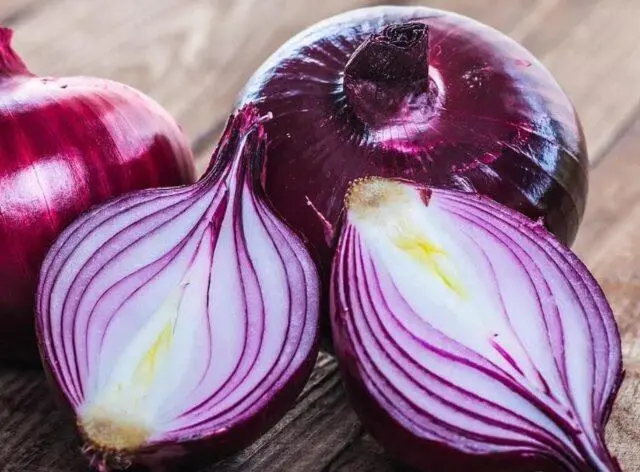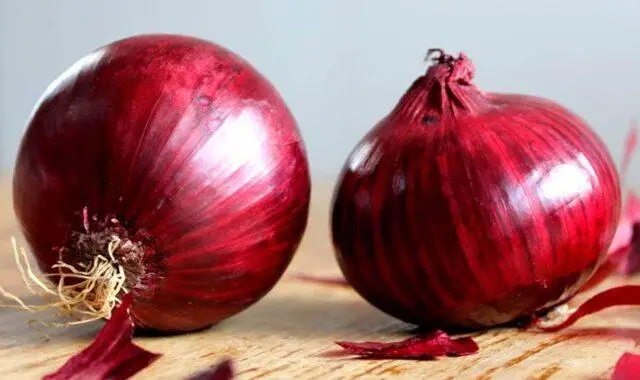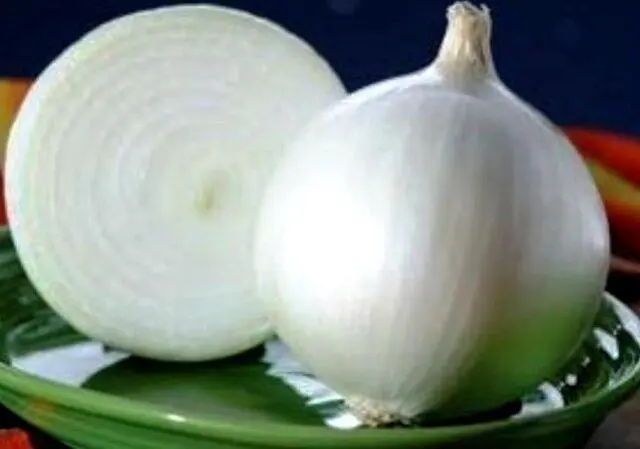Contents
Red onion differs from the usual not only in color, but also in taste. It is not as spicy, but sweet and fragrant. This allows the red varieties to be used in salads and other vegetable appetizers. Other differences are related to the characteristics of cultivation and the price.
The difference between red and regular onions
Red onion, which is also called purple, sweet, Crimean or Yalta, differs from the usual not only in appearance. They have a different chemical composition, taste. Each culture has its own characteristics of cultivation and application.
Appearance
First of all, the purple onion differs from the usual appearance. Classical Yalta bulbs have a flat-round shape. Although there are many red varieties with oval or elongated bulbs, i.e. the same as in ordinary onion culture.
The main difference has to do with color. Dry scales (first 1-2) of the Yalta variety have a rich dark purple color. Juicy scales are pure white, however, their outer side is also purple. Due to this, the alternation of light and dark bands is visible on the section.

The colored vegetable looks beautiful when serving the main course, as well as in salads and other snacks.
Flavour and Fragrance
Differences between yellow and red varieties are also related to taste and aroma. The spiciness of a red onion is less than that of a regular onion. This figure depends on the variety and growing conditions. The taste of red varieties is sweetish, salad type. The aroma is typical onion. Therefore, red root vegetables, unlike ordinary ones, are often used fresh in salads.
Properties and composition
The differences between blue onions and ordinary onions are also related to the chemical composition. In general, it coincides – both types of plants contain vitamins, minerals and other valuable compounds:
- magnesium;
- potassium;
- iodine;
- sulfur;
- iron;
- cobalt;
- vitamins A, P, C, group B.
An important difference is due to the fact that red onions also contain anthocyanins. These are organic substances that provide a characteristic purple color. They are also present in many other plants of the same color range, for example, in plums, blueberries, cherries and others.
At the same time, the energy value of red and ordinary root crops is approximately the same. There is no difference in calories. For 100 g of fresh pulp, the indicator is 41-45 kcal. There are also no differences in nutritional value:
- proteins – 1,1 g;
- fats – 0,1 g;
- carbohydrates – 9,3
Growing rules
If we talk about such an important indicator as growing characteristics, then red onions also have several important differences in comparison with ordinary onions. Bright varieties, like the rest, are grown from seeds or sets. But they are more thermophilic, require regular watering and top dressing.
Red onions are grown in the Krasnodar Territory, the North Caucasus and other southern regions. Less commonly, the crop is cultivated in the middle lane, even less often in regions with short summers and extremely frosty winters (Urals, Siberia).

One of the important differences between red onions is their exactingness in growing conditions.
If we talk about the features of agricultural technology, we can distinguish several rules for growing. For red varieties, the following requirements are relevant:
- Watering should be regular – at least once every 10 days. During the dry season, water is given at least once a week.
- Top dressing is applied 2-3 times per season: the first time two weeks after germination, the second – closer to the beginning of July, the third – after 2-3 weeks. For good yields, complex mineral compositions and organics are used.
- Regularly loosen the soil, do weeding.
- Plantings are also mulched to protect the bulbs from frost, and the soil from drying out.
Feature of application
Blue, ordinary and white onions differ from each other not only in taste, but also in the features of application. In this regard, it is the red variety that wins, as well as the white variety. They are great for different salads, they are widely used fresh.
Yellow
The difference between the usual yellow varieties is that they all have a more or less sharp taste. The composition contains a large amount of phytoncides and essential oils. They provide a sharp, and even bitter taste. However, it completely disappears during even a short stew, frying or boiling.
It is not recommended to use raw onions for salads. They will make the taste too spicy and can lead to indigestion. To avoid this, it is recommended to cut pieces of the desired size and pour boiling water over them for 1-2 minutes, then put them in a colander and carefully drain all the water.
Due to the high content of substances that destroy viruses and bacteria, yellow varieties are most often used to treat respiratory diseases, sore throats, and stomatitis. For example, onions can be chopped in a blender, get juice, squeeze the cake thoroughly. The liquid is then mixed with sugar, some water is added and taken several times a day to treat coughs and sore throats.
White

White onion belongs to salad
Its differences are due to the fact that it is less sharp. Therefore, white onions are used in salads, for serving the main course (for example, fish). It can be used for frying, boiling and stewing, as well as for preparing pickles and marinating.
Red
Red onion also differs from yellow in terms of application. It is often used in salads. Moreover, unlike conventional culture, Yalta can be used fresh without prior blanching (keeping in boiling water for several minutes).
Another area of application is cosmetic. Red onion juice is easy to get at home using a blender or meat grinder. It is mixed with honey or other ingredients and rubbed into the scalp to strengthen the hair follicles. This measure prevents hair loss.
Which bow is better to choose
There are quite a few differences between red and ordinary onions. Therefore, it is not always possible to say unambiguously which one is better. Yellow varieties have the following advantages:
- more intense spicy taste;
- can be used to treat viral and bacterial diseases;
- affordable price;
- suitable for pickling and marinating.
Red onion has its own advantages:
- less spicy, sweetish taste;
- pleasant aroma;
- attractive coloring;
- great for salads;
- can be used in cosmetology.
It is with these qualities that the differences in its application are associated. Red onions are great for salads. It can also be used as part of various masks to strengthen hair.
Which bow is more useful: red or regular
The differences between red onions and regular yellow ones are due to the fact that, in general, the former is more useful. Eating a fresh vegetable benefits the body, which is manifested in the following:
- healing of wounds, pustules;
- bactericidal action;
- improvement of metabolic processes due to vitamins and minerals;
- decrease in the level of intoxication;
- improving digestion by increasing the acidity of the stomach;
- destruction of worms;
- decrease puffiness;
- skin rejuvenation;
- stimulation of hair growth.

Red onion is healthier than regular onion
Why are red onions more expensive than regular onions?
The differences between colored and ordinary onions are also related to the price. The red varieties are almost always more expensive than the bulb varieties (even in the fall season). The main reason is that in Our Country red onions are grown in much smaller volumes. Therefore, there are additional costs associated with such factors:
- transportation;
- customs duty;
- exchange rate difference.
Red onions are more demanding to care for. This further increases costs. On average, red varieties are more expensive than yellow ones. The figure is at least twice as high.
Conclusion
Red onion differs from the usual in appearance, taste, cultivation features. There is also a noticeable difference in price. Red onions are healthier than yellow ones. Therefore, they can be used equally with each other. If there are diseases of the digestive system, it is better to use not fresh, but in a thermally processed form.









